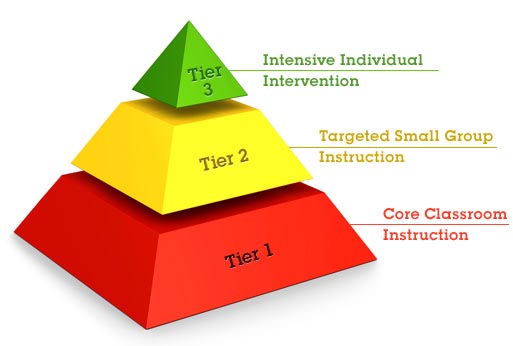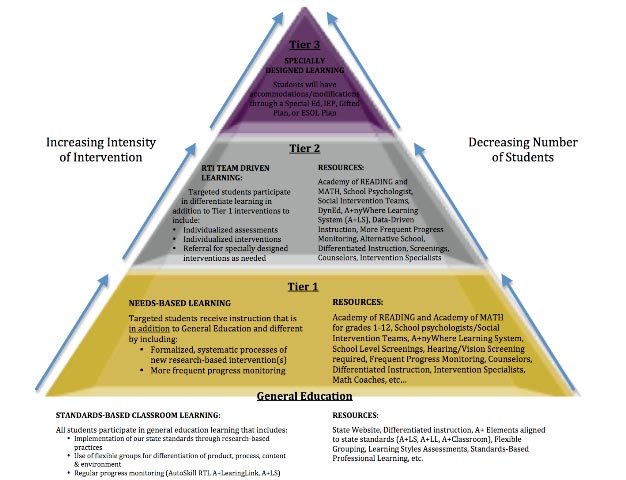Response to Intervention (RTI)

Quick facts about response to intervention:
- Defined as a multi-tier approach to identifying and accommodating students with learning difficulties
- Sometimes known as response to instruction, responsiveness to intervention, or continuum of support (Canada)
- Considered a proactive alternative to the 'discrepancy model' for identifying learning disabilities
- Tiers typically include: 1) regular classroom instruction, 2) small group support, and 3) high intensity one-on-one or small group interventions
- Mostly a U.S. model, but its influence extends to Canada and the U.K.
- Students often receive interventions from more than one tier at the same time
- Some kind of student assessment often takes place at the outset of instruction and then periodically thereafter
- Proponents highlight the elimination of labels, and the rapid and universal application of interventions (no more 'waiting to fail')
- Critics note that RTI does not consistently meet the unique needs of individual students. Students with dyselxia for example require particular kinds of interventions that may or may not be offered under RTI
Quick links to:
Definition
Response to Intervention or RTI is one of the latest buzzwords of education. Taken literally it is a strange phrase that has a medical tone, as if it might be a description of how a patient is responding to his or her new medication (intervention). While we don't like medical analogies when it comes to dyslexia, this is an apt description.
RTI is indeed a method of diagnosis and treatment, but diagnosis of learning disabilities rather than medical conditions. Essentially it refers to the process whereby students are identified as learning disabled based on their response to instruction and support, provided at various levels of intensity. If students 'respond' to additional support and close the gap with their peers, then they return to regular instruction. Students who don't respond receive increasing levels of support. Those not responding to the highest levels of support may be identified as learning disabled.
Response to intervention and IDEA
Changes to the Individuals with Disabilities Education Act (IDEA) legislation in 2004 advanced Response to Intervention as an alternative to previous approaches for identifying learning disabilities based on a discrepancy between intelligence and performance—an approach discredited by research findings that those with learning disabilities span the full range of intelligence.
This change to IDEA fueled the rise of Response to Intervention as an approach to learning disabilities in the period since. Below is the critical section of the revised IDEA legislation:
IDEA Section 614
"(A) In general.--Notwithstanding section 607(b),
when determining whether a child has a specific learning
disability as defined in section 602, a local
educational agency shall not be required to take into
consideration whether a child has a severe discrepancy
between achievement and intellectual ability in oral
expression, listening comprehension, written expression,
basic reading skill, reading comprehension, mathematical
calculation, or mathematical reasoning.
"(B) Additional authority.--In determining whether a child has a specific learning disability, a local educational agency may use a process that determines if the child responds to scientific, research-based intervention as a part of the evaluation procedures described in paragraphs (2) and (3).
Components
To no surprise, there are many interpretations of what a Response to Intervention model should include (Fuchs, Fuchs, & Compton, 2012). But the following features are common to most of them:
- A high quality (evidence based) core curriculum delivered by professional staff
This is less a feature than a prerequisite. The delivery of the core curriculum to mainstream students must be sound otherwise there is no way to know if student difficulties result from learning disabilities or from bad teaching.
Not surprisingly, most descriptions of RTI provide only lip service to this essential requirement without contemplating its actual implementation or consequences. How the professionalism of teachers and the curriculum might be established is a very hot potato indeed—too hot for most school boards to handle. Proper paper credentials set a kind of floor for professional standing but little more. In fairness, school boards always have some annual teacher assessment process, but these instruments rarely result in terminations, promotions or retraining.
- A hierarchy of interventions (tiered instruction)
At the heart of RTI is its tiered approach for matching student need with instruction intensity. Usually there are three tiers, never less, but sometimes more. Like many simple ideas, a three tiered system is remarkable confusing on closer examination. Most three tier systems are really only two tier systems because the first 'tier' is simply the the delivery of mainstream curriculum in the mainstream classroom to all students:
 Classic RTI model. Notice how three tiers are really just two
Classic RTI model. Notice how three tiers are really just two A genuine three tier RTI model
A genuine three tier RTI model-
Ongoing assessment
Typically, RTI requires regular assessment of student progress to determine the appropriate interventions to apply. Note that students do not usually progress through the tiers in a linear kind of way, but rather receive different types and durations of interventions as needed. In other words, students may not be formally categorized as being 'in' a particular tier. Ideally all students are tested at least a couple times per year; struggling students more often. The actual tools used for assessment vary from district to district and board to board but The Center on Multi-Tiered System of Supports lists these ones. You will notice a lot of overlap with our list of dyslexia assessment tools.
Paradoxically some RTI champions emphasize that RTI does not require assessment, or at least not initially. Struggling students, they claim, can begin receiving instruction at a higher tier immediately rather than 'waiting to fail' as occurs under models that require detailed student assessments before adjusting learning plans.
The tiers (classic model)
IDEA always trumps RTI
As a parent it's important to know that regardless of whether your school uses a response to intervention model, your rights under federal law remain unchanged.
The IDEA legislation allows
parents to request a formal evaluation at any point in order to determine eligibility for
special education support. RTI cannot be used to refuse or delay a
formal evaluation.
So remember that you don't have to wait for your school's RTI process to grind along before seeking additional assessments and interventions for your child. If you're eligible, you're eligible right now.
Tier 1: Universal classroom instruction with group interventions (80-90% of students)
Most descriptions of Tier 1 equate it with the mainstream classroom approach, encompassing 80-90% of students. When this is the case, the description of the tier usually reads along the lines of.... professional instruction.... evidence based curriculum... quality core instruction, and so forth. Beyond platitudes, Tier 1 sometimes includes capacity for 'differentiated instruction', allowing for some individualized support in the regular classroom. But essentially tier one is not a tier, it is just business as usual: undifferentiated, whole group instruction.
Tier 2: Small group support (10-15% of students)
Students who fail to make adequate progress in the mainstream classroom, or who have been identified as requiring extra support, receive interventions at the Tier 2 level providing increasingly intensive
instruction in their area(s) of weakness, sometimes from a support teacher working alongside the classroom teacher. At this level, interventions typically take place in small groups,
usually in the mainstream classroom, often at a separate work station. The extra support may only amount to 2-3 hours a week. The subject of the intervention is usually reading or math.
The objective of Tier 2 is to eliminate deficits and close the gap with students working at Tier 1. Students who show little progress at this level of intervention are considered for more intensive interventions in Tier three. Students who do well at this level may return to only Tier 1 interventions.
Some Response to Intervention models define a duration of time that students should receive Tier 2 interventions before being able to return to Tier 1. Implicit in any such model is that belief that student deficits are temporary and tractable, something most educators know is not usually the case. In short, some student may move fluidly into and out of different intervention intensities, but many will always require some level of additional support.
Tier 3: Intensive individual support (5-10% of students)
At this level, students receive more individualized, intensive and explicit interventions targeting their areas of need. The support may be offered in the classroom, but now is more likely to take place elsewhere in the school to reduce distractions or to access additional teaching resources such as assistive technology. Even at this level students may receive only several hours of extra support per week. Some Tier 3 interventions take the form of full or part time instruction in stand alone classes. These groupings are referred to as systems classes, congregated classes or just 'special education classes'. Some parents and educators oppose these segregated classes, advocating for more 'inclusive classrooms', but the reality is they often serve high needs students best, protecting them from performing poorly in front of their peers, bullying, while providing the kinds of intensive instruction some students need day in and day out.
What kinds of interventions are students receiving at Tier 3? If done right instruction will be personalized, multisensory, structured, sequential, structured and cognitive. See our Programs that Work page for more details on intensive instruction.
Notionally, the goal at this level is reduce or eliminate deficits and return the student to Tier 2 support. But many students will require Tier 3 kinds of interventions their entire academic life. Students who do not improve at Tier 3 likely have learning disabilities and are often given additional assessments to determine eligibility for support under special education law such as the Individuals with Disabilities Education Act (IDEA).
RTI and Child Find
Does Response to Intervention make the 'Child-Find' provisions of the IDEA legislation irrelevant?
Recall that under IDEA, public school districts have an obligation to identify, locate, and evaluate students who they suspect to have a disability. The objective being to catch any disability early and determine eligibility for special education resources. But Response to Intervention is designed to find students with disabilities by monitoring their progress on a day to day basis and ramping up interventions as necessary. In theory RTI will eventually find every child with a learning disability in an district that adopts the approach.
This creates an obvious tension between RTI and Child Find, one that schools have to handle carefully. Parents are still free to request formal evaluations of their child if they suspect a problem and schools must respond with either an evaluation or an explanation as to why they are not assessing.
Future changes to the IDEA legislation may put this tension to rest, but for now the best advice for parents and schools is to maintain open communication about all aspects of a students program. Schools need to know that provision of assessments and accommodations under RTI do not fulfill Child Find obligations and parents need to know that securing an assessment for their child does not guarantee better remediation than might already exist under RTI.
Final thoughts
RTI, though a flawed solution to complex problems facing teachers, parents and school administrators, is still a workable model that can potentially help every student under it. We think it offers real value for parents and teachers.
In essence Response to Intervention is simply the process of providing students a bit of individualized help (Tier 1), some help (Tier 2) or a lot of help (Tier 3). There is nothing complicated about this and yet it is much better than the recent past when there was only Tier 1 for the vast majority of students in need. Under RTI many more students will get the extra help to build the skills and confidence that will carry them throughout their lives—a huge step in the right direction.
As a parent just be sure to inquire which interventions are being applied to your child under RTI. If your child has dyslexia, then the interventions should be ones known to work for dyslexics, otherwise the extra support won't help close existing learning gaps.
Back to the top of Response to Intervention
- Home ›
- Dyslexia Test ›
- Response to Intervention
New! Comments
Share your thoughts or ideas! Leave us a comment in the box below. You can post it at this site only or on Facebook too, it's up to you.